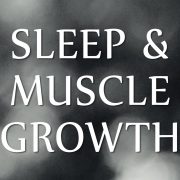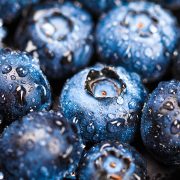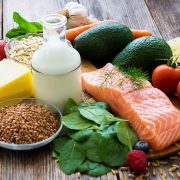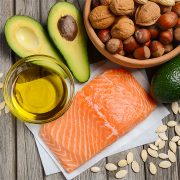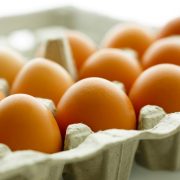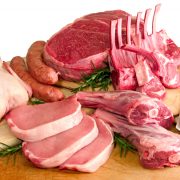What and How Much to Eat to Improve Recovery and Get Stronger and Faster
To the surprise of many, strength training (kettle bells, free weights, medicine balls & stretch cords) and cardiovascular exercise (running, Concept 2 rowing, cycling, swimming, etc.) alone won’t make you fitter and faster! In fact, there are only two things that you can do to improve your speed and endurance: sleep and good nutrition. We will discuss the importance of sleep in the near future, but within this article, we will discuss why proper protein intake on a daily basis is not only necessary to reach your full athletic ability, but also important to your long term health (specifically low percentage of body fat and high percentages of lean muscle).
The use of interval training and strength training to build muscle and burn fat is only beneficial if your body receives the necessary type and amount of amino acids to rebuild the torn down muscles. Most imperative is the body’s ability to absorb what it consumes.
Lets take a look at when to eat, what to eat and determine how much to eat for optimal health and performance
PROTEIN INTAKE – BEFORE EXERCISE
The purpose of having protein before you exercise is to prevent muscle protein breakdown and to promote muscle protein synthesis. This is fancy talk for preserving the muscle you already have, and helping to promote the growth of new muscle tissue.
According to Bariatric Registered Dietitian, Derek Helderman , recent research has shown that consuming protein before exercise can decrease, or at least prevent the increase of, markers of muscle damage (myoglobin, creatine kinase and myofibrillar protein degradation) more than groups who consumed just carbohydrates or placebos. This is one of the key reasons to have protein before you train, as reducing the damage to the muscles can improve recovery time and cause better adaptations to training over the long-term. In addition, protein consumed before training will flood your blood stream with amino acids as your body needs them, beginning the process of creating new muscle while you are training!
Aim to consume about 15-40 grams of protein within 30-90 minutes before training, depending on your size and needs. This can be consumed either in a shake or a mixed meal.
PROTEIN INTAKE – POST EXERCISE
When you are finished with your workout, you have two priorities relevant to recovery. First, is to replenish depleted stored sugar levels (glycogen) in the liver and muscles and second is to rebuild the muscles, tendons and ligaments stressed during exercise.
The period of time at which you consume protein following a workout is also important. According to a review published in the February 2008 edition of “Strength and Conditioning Journal,” sport nutritionist Dr. Jose Antonio concluded that protein cell turnover, or the process by which your body begins to synthesize new protein cells and rids itself of old ones, occurs at an increased rate within one hour following exercise. This is the most effective time for consuming a post-workout supplement.
On the flip side, waiting too long can compromise the beneficial adaptations to training, and decrease your results. So while you don’t have to slam down a shake immediately after training, it wouldn’t be in your best interest to wait for three hours either.
Aim to consume about 15-40 grams of protein within 30 minutes after training, again depending on your size and needs. Whether this is consumed as a shake or a solid meal is solely dependent on what best fits your needs
PROTEIN SOURCES
You can consume protein from whole foods, protein supplements or amino acid supplements. Whole foods include basic dietary sources such as milk, snack bars and meats. Protein supplements come in powder form and are generally extracted from milk, soy, wheat or eggs. Extracting specific essential amino acids, the building blocks of all protein molecules, can be an effective post-workout supplementation method as well. Your body is also at an increased need for fluid and carbohydrates following a workout because of losses in water and electrolytes through sweat and depleted glycogen stores. A beverage that contains about a 4:1 ratio of carbohydrates and protein appears to be ideal for post-workout recovery.
As outlined by Physician, Dr. Joseph Mercola, a fast-assimilating protein, such as whey protein is one of the easiest and most nutritionally rewarding food to consume pre and post workout. He writes,
” … in terms of current recommendations it appears that consumption of ~ 20–25g … of a rapidly absorbed protein may serve to maximally stimulate MPS after resistance exercise in young healthy individuals. Ideal candidates to fulfill such criteria appear to be whey or bovine milk.”
As research has documented, whey protein is superior to other milk proteins for building muscle because the amino acids found in bioavailable whey protein activates certain cellular mechanisms (mTORC-1), which in turn promote muscle protein synthesis, as well as boost thyroid and also protect against declining testosterone levels after exercise.
Researchers stress that high-quality leucine-rich proteins, such as whey, may be particularly important for the elderly to maximize muscle protein synthesis. Leucine is part of branched-chain amino acid that serves multiple functions in your body, one of which is signaling the mTOR (Mammalian Target of Rapamycin) mechanism to increase protein synthesis and build your muscle.
The review noted that adding free leucine to meals did not appear to be an effective strategy to enhance muscle mass or strength over a 12-week period, and you should be aware that taking leucine as a free form amino acid supplement can be counterproductive and wrought with side effects.
To reap the associated benefits without the side effects, make sure you get your leucine from food only. The typical requirement for leucine to maintain body protein is 1-3 grams daily. However, to optimize its anabolic pathway, you need an estimated 8-16 grams of leucine daily, you only need three ounces of high-quality whey to reach the eight-gram requirement, compared to 1.5 pounds of chicken, or about 16 eggs, or half a pound of raw cheddar cheese!
IMPORTANT POINTS ABOUT HIGH-QUALITY WHEY
There’s no shortage of whey products on the market, but unfortunately most of them will NOT give you the health benefits associated with high-quality whey. First of all you want to use a whey protein concentrate, NOT isolate.
All whey protein isolates are devoid of nutritional co-factors including alkalizing minerals, naturally occurring vitamins, and lipids, which are lost in the processing. This renders them deficient and overly acidifying. Unlike whole protein food concentrates, which do not acidify your body due to their alkalinizing minerals, whey protein isolates are over acidifying. I would strongly avoid ALL whey protein isolates just as you would avoid trans fats as they contain putrid proteins that some experts believe to be worse than trans fat.
If chronically consumed in large amounts (such as with bodybuilders or athletes) without alkalizing foods, it can acidify your body and over time may lead to metabolic acidosis with consequences that include wasting of muscle and bone tissues, total metabolic shut down, and increased vulnerability to degenerative disease.
So if you want to use whey protein, PLEASE do not use an inferior whey isolate. Look for a high-quality concentrate instead. These are the factors you need to look for in order to ensure you’re buying a high-quality product:
| Organic (without hormones) | Grass-fed | Made from unpasteurized (raw) milk |
| Cold processed, since heat destroys whey’s fragile molecular structure | Minimally processed Concentrate
NO Isolates |
Rich, creamy, full flavor |
| Water-soluble | Sweetened naturally, not artificially | Highly digestible—look for medium chain fatty acids (MCTs), not long chain fatty acids |
Some of the best whey protein you can get today is derived from raw milk cheese manufacturing. They have very high-quality controls and produce great-tasting whey, with optimal nutritional content. Raw dairy products, such as raw milk or raw milk cheese, are another alternative.
Moreover, scientists have found that the ratio between protein and carbohydrates is critically important, especially as you age. Many make the mistake of eating too many carbs in relation to protein and fat. Research shows that high-carbohydrate diets fail to build muscle, even in younger people due to their detrimental effect on insulin. Again and again, it’s the high-protein/high-fat/low-carbohydrate diet that proves the most effective both for muscle building and weight loss.
AMINO ACIDS – ESSENTIAL BUILDING BLOCKS TO STRENGTHEN MUSCLES
As mentioned earlier, the amino acid leucine is one of the most important for fitness. It’s part of branched-chain amino acid found in certain foods, and serves multiple functions in your body, one of which is signaling the mTOR (Mammalian Target of Rapamycin) mechanism, which signals protein to be created and builds your muscle. But that’s not all.
Founder of Defense Nutrition and author of numerous publications, Ori Hofmekler explains:
“Leucine has shown to promote the anti-inflammatory cytokine interleukin 15 (IL-15), which has been regarded as the most powerful fitness promoting protein produced by your muscle. IL-15 acts as an anti-inflammatory, anti-obesity, muscle-regenerating signaling agent with unmatching effects on body transformation and anti-aging.
Furthermore leucine along with calcium blocks the obesity promoting effect of excess Vitamin D calciferol in adipose tissues (excess of vitamin d in fat cells induces central obesity which can be blocked by calcium/leucine intake such as from dairy, particularly whey protein). Finally, leucine/IL 15 anti-inflammatory actions have been linked to mitochondrial biogenesis, increased thermogensis, and increased energy utilization efficiency probably via activation of the longevity gene SIRT-1.”
Leucine also indirectly promotes the increase of glutathione in your body, as its anti-inflammatory actions can help spare glutathione molecules that would have otherwise be recruited to counteract inflammatory processes.
However, in order to be effective, you need far more than the recommended daily allowance (RDA) of leucine. The reason for this is because even though leucine is relatively abundant in our food supply, it does not appear in high concentrations, and is often wasted as an energy substrate or used as a building block rather than an anabolic agent. This means that to establish the right anabolic environment, you need to increase leucine consumption beyond maintenance requirements.
That said, keep in mind that using leucine as a free form amino acid can be highly counterproductive as when free form amino acids are artificially administrated, they rapidly enter your circulation while disrupting insulin function, and impairing your body’s glycemic control. Food based leucine is really the ideal form that can benefit your muscles without side effects. The highest concentrations of leucine and other branched chain amino acids (BCAA) are found in dairy products; particularly whey protein. and quality cheese.
Based on nitrogen-balance measurements, the requirement for leucine to maintain body protein is 1-3 grams daily. To optimize its anabolic pathway, you need an estimated 8g – 16g of leucine daily. The following chart presents leucine content in common foods. As you can see, whey protein is ideal for getting sufficient amounts of leucine in your diet. You only need three ounces of whey protein, compared to a pound and a half of chicken to get 8 grams of leucine:
Leucine Content in food / per 100g
| Whey Protein Concentrate | 8.0g |
| Raw Cheddar Cheese | 3.6g |
| Lean Beef | 1.7g |
| Salmon | 1.6g |
| Almonds | 1.5g |
| Chicken | 1.4g |
| Chick Peas | 1.4g |
| Raw Eggs | 1.0g |
| Egg Yolk | 1.4g |
| Sheep Milk | 0.6g |
| Pork | 0.4g |
| Cow Milk | 0.3g |
HOW MUCH PROTEIN TO CONSUME FOR OPTIMUM HEALTH AND PERFORMANCE
A protein supplement is only effective if you already consume adequate dietary protein. Most adults need to consume about 0.4g of protein per 1 lb. of body weight. Highly active adults and athletes have increased protein needs. Athletes who consistently perform strength training exercises should consume about 0.7 to 0.9g per 1 lb. of body weight. Endurance athletes should consume about 0.6 to 0.7g of protein per 1 lb. of body weight each day.
REFERENCE: “Performance Training Journal”; Protein Requirements for Athletes; Debra Wein, MD et al.; February 2011


